A multi-centric, single-blinded, randomized, parallel-group study to evaluate the effectiveness of nasoalveolar moulding treatment in non-syndromic patients with complete unilateral cleft lip, alveolus and palate (NAMUC study): a study protocol for a randomized controlled trial
- PMID: 38965585
- PMCID: PMC11223389
- DOI: 10.1186/s13063-024-08229-z
A multi-centric, single-blinded, randomized, parallel-group study to evaluate the effectiveness of nasoalveolar moulding treatment in non-syndromic patients with complete unilateral cleft lip, alveolus and palate (NAMUC study): a study protocol for a randomized controlled trial
Abstract
Background: Cleft lip and palate (CLP) are among the most common congenital anomaly that affects up to 33,000 newborns in India every year. Nasoalveolar moulding (NAM) is a non-surgical treatment performed between 0 and 6 months of age to reduce the cleft and improve nasal aesthetics prior to lip surgery. The NAM treatment has been a controversial treatment option with 51% of the cleft teams in Europe, 37% of teams in the USA and 25 of cleft teams in India adopting this methodology. This treatment adds to the already existing high burden of care for these patients. Furthermore, the supporting evidence for this technique is limited with no high-quality long-term clinical trials available on the effectiveness of this treatment.
Method: The NAMUC study is an investigator-initiated, multi-centre, single-blinded randomized controlled trial with a parallel group design. The study will compare the effectiveness of NAM treatment provided prior to lip surgery against the no-treatment control group in 274 patients with non-syndromic unilateral complete cleft lip and palate. The primary endpoint of the trial is the nasolabial aesthetics measured using the Asher McDade index at 5 years of age. The secondary outcomes include dentofacial development, speech, hearing, cost-effectiveness, quality of life, patient perception, feeding and intangible benefits. Randomization will be carried out via central online system and stratified based on cleft width, birth weight and clinical trial site.
Discussion: We expect the results from this study on the effectiveness of treatment with NAM appliance in the long term along with the cost-effectiveness evaluation can eliminate the dilemma and differences in clinical care across the globe.
Trial registration: ClinicalTrials.gov CTRI/2022/11/047426 (Clinical Trials Registry India). Registered on 18 November 2022. The first patient was recruited on 11 December 2022. CTR India does not pick up on Google search with just the trial number. The following steps have to be carried out to pick up. How to search: ( https://ctri.nic.in/Clinicaltrials/advsearch.php -use the search boxes by entering the following details: Interventional trial > November 2022 > NAMUC).
Keywords: CLP; Cleft lip and palate; NAM treatment; Nasoalveolar moulding; PSIO; Presurgical infant orthopaedics; Randomized controlled trials.
© 2024. The Author(s).
Conflict of interest statement
None of the authors or study members have any conflicts of interest. Dr. Pedro Santiago and Dr. Barry Grayson conduct courses to promote the NAM technique but do not receive any other financial benefits. Both clinicians will be involved in the calibration exercise and in training the study investigators on the clinical treatment protocol. However, they will not be involved in the study’s methodology, execution or dissemination.
Figures





Similar articles
-
Effects of nasoalveolar molding on nasolabial aesthetics in patients with cleft lip and palate during pre-adolescence: A systematic review and meta-analysis of retrospective studies.Orthod Craniofac Res. 2024 Jun;27(3):350-363. doi: 10.1111/ocr.12762. Epub 2024 Jan 30. Orthod Craniofac Res. 2024. PMID: 38288677
-
Active Presurgical Infant Orthopedics for Unilateral Cleft Lip and Palate: Intercenter Outcome Comparison of Latham, Modified McNeil, and Nasoalveolar Molding.Cleft Palate Craniofac J. 2018 May;55(5):639-648. doi: 10.1177/1055665618757367. Epub 2018 Feb 20. Cleft Palate Craniofac J. 2018. PMID: 29461877 Free PMC article.
-
Long-Term Comparison of the Aesthetic Outcomes between Nasoalveolar Molding- and Non-Nasoalveolar Molding-Treated Patients with Unilateral Cleft Lip and Palate.Plast Reconstr Surg. 2021 Nov 1;148(5):775e-784e. doi: 10.1097/PRS.0000000000008463. Plast Reconstr Surg. 2021. PMID: 34705782
-
Effectiveness of a Novel 3D-Printed Nasoalveolar Molding Appliance (D-NAM) on Improving the Maxillary Arch Dimensions in Unilateral Cleft Lip and Palate Infants: A Randomized Controlled Trial.Cleft Palate Craniofac J. 2020 Dec;57(12):1370-1381. doi: 10.1177/1055665620954321. Epub 2020 Sep 10. Cleft Palate Craniofac J. 2020. PMID: 32909815 Clinical Trial.
-
Long-Term Effects of Nasoalveolar Molding in Patients With Unilateral Cleft Lip and Palate: A Systematic Review and Meta-Analysis.Cleft Palate Craniofac J. 2022 Apr;59(4):462-474. doi: 10.1177/10556656211009702. Epub 2021 Apr 22. Cleft Palate Craniofac J. 2022. PMID: 33882703
References
-
- Vanderas AP. Incidence of cleft lip, cleft palate, and cleft lip and palate among races: a review. Cleft Palate J. 1987;24(3):216–225. - PubMed
Publication types
MeSH terms
Grants and funding
LinkOut - more resources
Full Text Sources
Medical
Miscellaneous

